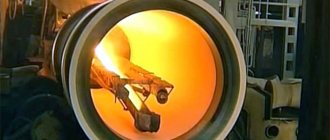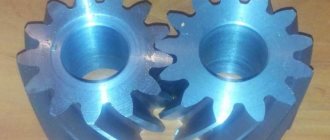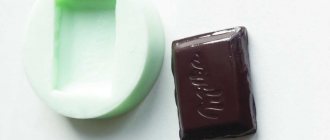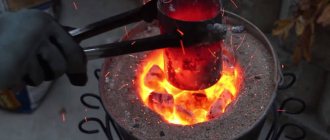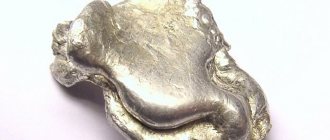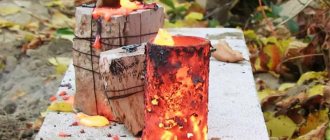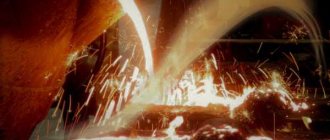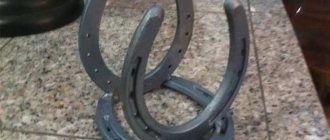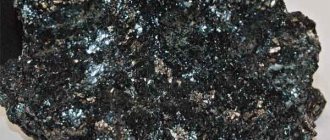History and essence of technology
Humanity became acquainted with metal a very long time ago, but the earliest attempts to produce castings from it most likely date back to the fourth millennium BC. e. Such assumptions allow us to make archaeological finds in the Middle East. According to research, the first molds filled with liquid metal were simple depressions in open ground.
The ancient masters did not immediately achieve significant progress in the accuracy and quality of castings. The first surviving artifacts that can be attributed to the sculptural genre date back to approximately the second or third millennium BC. During this period, casting became not only a craft item, but also a way to create high-level works of art.
The essence of the technology lies in the property of molten metal (like any other liquid) to fill the vessel into which it is poured. After cooling, the finished casting becomes an exact geometric copy of the voids in the container. The main steps look simplified like this:
- Production by a sculptor of an original model from plastic non-metallic materials.
- Preparation of materials for molding, creation of a casting mold based on the original.
- Melting metal, pouring it into a mold, cooling.
- Release of the finished product from the mold, cleaning and mechanical processing.
The process becomes significantly more complicated if it is necessary to create hollow castings or replicable products.
Specialization of our company
We are mainly engaged in the production of bronze products, including both their manufacture and restoration. Our experienced constructors and designers try to best combine the features of each metal structure with stone and crystal decorations. Further creative plans of the workshop include the development of the most unpredictable versions of new projects, in the construction of the artistic concept of which we will not refuse your help:
- Decoration of fireplaces, gates;
- Production of custom crosses and coats of arms;
- Casting chandeliers for high and low ceilings;
- Production of metal wall sconces
Bringing to your attention the online store of our company guarantees the use of only natural materials in production. When producing certain products, we do not resort to using ready-made template parts. Therefore, many elements of our collections are unique and often have specific names. Also, we do not at all reject various options for active creative co-authorship.
Materials used
The “Seven Ancients” is a list of iron, copper, tin, lead, silver, gold and mercury - humanity has been familiar with them for thousands of years. Precious metals were used to make jewelry, and the main material for artistic casting in the past was copper-based alloys. In modern times, cast iron and aluminum were added to them.
Artists throughout history have not limited themselves to the range of materials they can melt. For example, in the 19th century in Europe and Russia, products made of zinc and lead were popular, and modern sculptors often turn to stainless steel. But the classic materials for artistic casting, even today, are bronze and cast iron.
Bronze alloys
Alloys of copper with some non-ferrous metals (lead, tin, aluminum, beryllium) without the presence of zinc and nickel are called bronze. Copper with large impurities of zinc is brass. The latter is used mainly for the manufacture of cabinet sculpture and expensive furniture and interior fittings. Tin bronze has remained unchanged for centuries as the main material for artistic casting of large and small forms. Its advantages:
- negligible shrinkage;
- high turnover;
- not susceptible to porosity when cooling;
- high thermal conductivity;
- strength;
- corrosion resistance;
- elasticity;
- weldability.
Bronze casting is one of the oldest arts . Its use in different parts of the ancient world was widespread: people cooked in bronze dishes, wore bronze jewelry, used bronze tools, and fastened their clothes with bronze buttons. This era is known for the amazingly high quality of execution and unprecedented artistic power of sculptures that have survived to this day. Since those times, the bronze foundry tradition began, which has long outlived its century with the same name. Of course, alloys have been improved throughout history, but most of the technological processes of artistic casting have remained unchanged.
Gray cast iron
Bronze and iron are perhaps the most important materials in human history. It is not for nothing that they gave names to two eras of technological evolution - the Bronze and Iron Ages. Since iron casting required higher temperatures and complex furnaces, mankind mastered iron smelting somewhat later than bronze. According to some information, cast iron was poured in China 2 thousand years ago. The first mass products made from it in Europe and Russia were cannon barrels and cannonballs in the 15th century.
The evolution of furnaces and energy-intensive fuels for them quickly made high temperatures accessible not only to the military industry. The artistic use of cast iron began around 1500 with the production of tiles for stoves, monuments and fountains. A powerful impetus for the popularization of cast iron in art was the rapid development of metallurgical technologies in the second half of the nineteenth century and the industrialization that followed these events.
To prepare the sculpture, gray cast iron with a high phosphorus content is used as the most inexpensive alloy of iron and carbon suitable for casting. Phosphorus improves fluidity - this helps the metal to completely fill the mold. The property of phosphorus to increase the fragility of iron for artistic casting is not important, as is the inherent porosity of gray cast iron. The material has another important property - the attractive appearance of the finished product.
Properties of zinc alloys
Products made from zinc alloys are used in various industries and households. For example, when assembling automotive equipment, zinc alloys are used in the manufacture of some body parts, filters and many others. The electrical industry uses zinc to produce brush holders. Alloys made from this material have high ductility. And this property allows it to be used to produce castings of complex shapes with thin walls. Zinc casting alloys do not react chemically with the metal of the mold and do not stick to its surface. The parameters of these materials allow the production of threaded parts.
Properties of zinc alloys
Meanwhile, the mechanical properties of zinc and its alloys are characterized by the fact that the tensile strength lies in the range of 20 - 38 kgf per square meter, and the Brinell hardness is 65 - 110 units. Castings made of zinc alloys have low surface roughness and dimensional accuracy. The workpieces obtained by injection molding are well processed by pressure and cutting. Meanwhile, zinc alloys have a high density - 7 kg per decimeter, and this is comparable to steel. They do not have very high resistance to corrosion. The presence of substances such as lead, cadmium and some others in the alloy results in accelerated aging processes. It is accompanied by a decrease in mechanical parameters and a change in the volume of the casting. In addition, alloys made from these materials are characterized by increased porosity.
To improve the strength properties and give zinc alloys good corrosion resistance, magnesium is introduced into their composition; its concentration should not exceed 0.1%. In addition to this, fairly traditional methods are also used - nickel plating, cadmium plating, etc. The properties of the alloy are determined by the presence of certain substances in the alloy composition.
Methods used
Traditional technologies have not lost any of their relevance in our time. As a basic technique, craftsmen use casting either in earth molds or using lost wax models. The 19th century saw the height of the rivalry between these two methods. The first became widespread mainly among industrialists, losing leadership in art to more accurate and expensive wax casting.
Casting into the ground
This method combines casting into earth, sand or clay. The main difference between them is the mold material. The essence of the technology is to obtain an imprint from a template on the mixture with a further change in its quality (tamping, adding a binder) and the subsequent formation of a gating system in it - channels through which molten metal will flow in and out.
To create complex three-dimensional figures, collapsible templates are often used, and molding is carried out in special composite boxes - flasks. The composition and quality of the molding sand has a great influence on the result. After casting, burrs and channel lines are removed mechanically.
Advantages of the technology:
- simplicity;
- low cost;
- the ability to create castings of large sizes and masses.
By investment models
This method was popular in Ancient Egypt and China, was used in Greece and Rome, and has not undergone much change over the millennia. The main evolutions occurred in auxiliary materials: craftsmen replaced wax with synthetic mixtures, began to actively use elastic rubber molds, etc. The classic method of melted wax casting looks like this:
- Creation of a wax model by a sculptor - an exact copy of the future casting.
- Making a mold - a paste-like gypsum-clay mixture is applied to the surface of the wax in several stages.
- Baking the mold in the oven. During heating, the wax leaves the mold, flowing through pre-designed channels.
- Pouring molten metal into voids left by wax.
- Freeing the finished sculpture from the clay mold.
- Removing excess metal from a casting, grinding, polishing, artistic chemical treatment.
In this form, this ancient method is now very popular among artists. The casting process becomes more complicated when it is necessary to create replicable products. Then procedures for making “negative models” are added to the work regulations, the purpose of which is to serve as a reusable mold for wax castings.
The lost wax molding method itself allows you to create extremely high-quality and thin products from all types of metals. Technological difficulties can arise only in the manufacture of large elements: such tasks can only be accomplished by highly qualified craftsmen.
